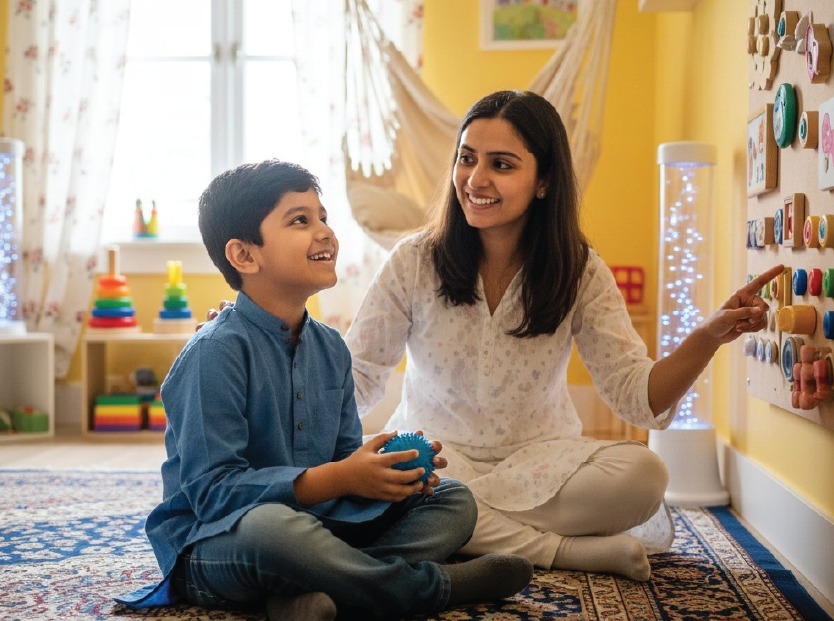Understanding Hand Flapping in Children with Autism
Every child has their own special way of expressing feelings. Some children jump when they’re happy, some clap, and some flap their hands. For many children with autism, hand flapping is a common way to express emotions or handle how their body feels.
At Adhyayan Inclusive Learning Centre, we believe that hand flapping is not something to be “stopped” or “punished.” Instead, it’s something to understand. When we know why a child is doing it, we can help them find better, safer, and more comfortable ways to express themselves.
Why Do Children Flap Their Hands?
Hand flapping is a form of stimming — short for “self-stimulatory behavior.” It can happen for many reasons, such as:
-
Feeling excited or happy
-
Feeling nervous, anxious, or overwhelmed
-
Trying to handle too much noise, light, or other sensory input
-
Wanting to communicate something but not knowing how to say it
So, instead of trying to stop hand flapping, our goal is to understand what the child is feeling and help them regulate in healthier ways.
Step-by-Step Approach We Follow
Step 1: Observe and Understand
The first step is always to watch carefully. We note down when and why the child flaps their hands — what’s happening before, during, and after.
This helps us see whether the behavior is due to sensory needs, emotions, or communication.
For example:
-
Is the child flapping when there’s loud noise? (sensory)
-
When they’re excited to play? (emotional)
-
When they want to say something but can’t? (communication)
Step 2: Meet the Child’s Needs
Once we understand the reason, we work on giving them what they need — in a better, more helpful way.
If it’s Sensory-Seeking:
We give them activities that provide the right kind of sensory input, such as:
-
Pushing or pulling objects (heavy work)
-
Jumping, crawling, or doing animal walks
-
Playing with playdough, slime, or sand
-
Using fidget toys or hand massages
If it’s about Emotional Regulation:
We help them calm down and understand their feelings.
-
Create a cozy “calm-down corner” with soft toys or a weighted blanket
-
Practice simple breathing exercises: “Smell the flower, blow out the candle”
-
Use feeling charts or pictures to identify emotions
If it’s about Communication:
We teach the child how to express themselves in other ways.
-
Using words, signs, or pictures to say “I’m excited” or “I need a break”
-
Teaching PECS or AAC for nonverbal communication
Step 3: Teach Simple Alternatives
Once we know what the child needs, we show them other ways to do it.
For example:
-
Squeezing a stress ball when excited
-
Clapping softly instead of flapping
-
Giving themselves a gentle hug
These are small changes that can make a big difference over time.
Step 4: Practice and Encourage
We gently remind, show, and celebrate progress.
-
Model calm behavior: “When I feel happy, I squeeze my ball!”
-
Use soft prompts: “Let’s use your calm hands.”
-
Praise every effort: “Great job using your fidget!”
Positive words go a long way in helping children feel safe and motivated.
Step 5: Add a Sensory Routine
A daily sensory routine (30–45 minutes) can really help children regulate their energy.
Activities like jumping, pushing, deep pressure play, or tactile games help their body stay calm and balanced through the day.
Our Approach — Compassion Over Control
At Adhyayan, we always focus on understanding, not controlling. Hand flapping isn’t wrong — it’s communication. When we listen to it with patience and care, we can help children find better ways to express their emotions and stay comfortable in their world.
Every child deserves to be understood, supported, and celebrated — and that’s exactly what we aim to do at Adhyayan Inclusive Learning Centre.
Need Support for Your Child?
If your child shows repetitive movements or sensory behaviors and you’re not sure what they mean, don’t worry — we’re here to help.
Our team of speech and occupational therapists in Delhi and Faridabad specialize in helping children with autism build self-regulation, confidence, and communication skills.
